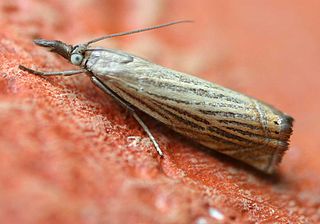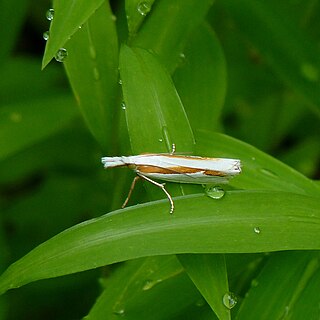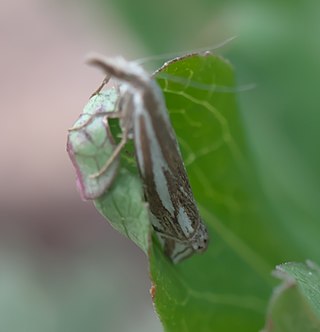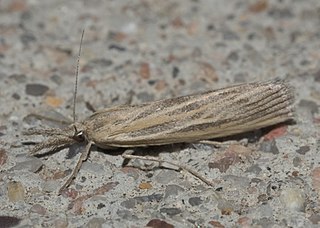
Girdling, also called ring-barking, is the circumferential removal or injury of the bark of a branch or trunk of a woody plant. Girdling prevents the tree from sending nutrients from its foliage to its roots, resulting in the death of the tree over time, and can also prevent flow of nutrients in the other direction depending on how much of the xylem is removed. A branch completely girdled will fail and when the main trunk of a tree is girdled, the entire tree will die, if it cannot regrow from above to bridge the wound. Human practices of girdling include forestry, horticulture, and vandalism. Foresters use the practice of girdling to thin forests. Extensive cankers caused by certain fungi, bacteria or viruses can girdle a trunk or limb. Animals such as rodents will girdle trees by feeding on outer bark, often during winter under snow. Girdling can also be caused by herbivorous mammals feeding on plant bark and by birds and insects, both of which can effectively girdle a tree by boring rows of adjacent holes.

The genus Crambus includes around 155 species of moths in the family Crambidae, distributed globally. The adult stages are called crambid snout moths, while the larvae of Crambus and the related genus Herpetogramma are the sod webworms, which can damage grasses.

Chrysoteuchia culmella, the garden grass-veneer, is a species of moth of the family Crambidae. It was first described by Carl Linnaeus in his 1758 10th edition of Systema Naturae. It is found in Europe.

Otiorhynchus ovatus, the strawberry root weevil, is one of the many species in the weevil family (Curculionidae), occurring across Canada and the northern United States. The species was first described by Carl Linnaeus in his landmark 1758 10th edition of Systema Naturae. Its name comes from its affinity for strawberry plants, which form a large part of its diet. They are, however, known to feed on other plants as well. Occasionally the larvae cause serious damage to seedlings and young transplants in plantations and nurseries. It is known to be one of the major pests threatening sub-tropical strawberry farming.

Chrysoteuchia is a genus of moths of the family Crambidae described by Jacob Hübner in 1825. Most are native to Asia.

Abantiades latipennis, known as the Pindi moth, is a species of moth in the family Hepialidae. It may also be referred to as a swift moth or a ghost moth, as this is a common name associated with Hepialidae. Endemic to Australia and identified in 1932, it is most populous in temperate rainforest where eucalypti are prevalent, as the larvae feed primarily on the roots of these trees. Females lay eggs during flight in a scattering fashion. The larvae live for over eighteen months underground, while adult moths survive for approximately one week, as they have no mouthparts with which to feed. The moths are preyed upon by a number of predators, including bats and owls. Brown in colour overall, males are paler and the identifying silver bars of the male's wings are more prominent than those of the female's, with dark margins. Male adults are generally smaller.

Euxoa detersa, the rubbed dart, sandhill cutworm or sand cutworm, is a moth of the family Noctuidae. The species was first described by Francis Walker in 1856. It is found in North America from Newfoundland to North Carolina, west to Nebraska, north to Alberta and the Northwest Territories.

Oxyptilus pilosellae is a moth of the family Pterophoridae first described by Philipp Christoph Zeller in 1841. It is found in most of Europe, east to Russia and Asia Minor. It was released as a biological control agent for Hieracium in New Zealand in 1998.

Crambus girardellus, or Girard's grass-veneer moth, is a moth in the family Crambidae described by James Brackenridge Clemens in 1860. It is found in North America, including Alberta, Ontario, Quebec, Labrador, Maine, New Hampshire, Massachusetts, New York, Pennsylvania, Maryland, Ohio and Michigan.

Dioryctria auranticella, the ponderosa pineconeworm moth, is a moth of the family Pyralidae. The species was first described by Augustus Radcliffe Grote in 1883. It is found in western North America from southern British Columbia south to California and Arizona, east to South Dakota and New Mexico.

Glaphyriinae is a subfamily of the lepidopteran family Crambidae. It was described by William Trowbridge Merrifield Forbes in 1923. The subfamily currently comprises 509 species in 75 genera.

Agriphila ruricolella, the lesser vagabond sod webworm, is a moth in the family Crambidae. It was described by Philipp Christoph Zeller in 1863. It is found in North America, where it has been recorded from Quebec and Maine to South Carolina, west to Arizona and north to Alberta. The habitat consists of grasslands, weedy areas, fields and cultivated areas.

Crambus whitmerellus, or Whitmer's grass-veneer, is a moth in the family Crambidae. It was described by Alexander Barrett Klots in 1942. It has been recorded in North America from Alberta, Montana, Wyoming, Colorado and Utah. The habitat consists of grasslands.

Crambus leachellus, or Leach's grass-veneer, is a moth in the family Crambidae. It was described by Johann Leopold Theodor Friedrich Zincken in 1818. It is found in North America, where it has been recorded from Ontario and Maryland to Florida, west to California and Oregon. The habitat consists of grasslands and meadows.

Crambus quinquareatus, the large-striped grass-veneer, is a moth in the family Crambidae. It was described by Philipp Christoph Zeller in 1877. It is found in North America, where it has been recorded from Alabama, Florida, Georgia, Louisiana, Maryland, Mississippi, North Carolina, Oklahoma, South Carolina and Texas.

Crambus saltuellus, the pasture grass-veneer, is a moth in the family Crambidae. It was described by Philipp Christoph Zeller in 1863. It is found in North America, where it has been recorded from the north-eastern United States south to North Carolina. It is also present in southern Ontario.
Crambus unistriatellus, the wide-stripe grass-veneer, is a moth in the family Crambidae. It was described by Alpheus Spring Packard in 1867. It is found in North America, where it has been recorded from British Columbia, Alberta, Labrador, Maine, Michigan, New Hampshire, New York, Pennsylvania, Minnesota and California. The habitat consists of grasslands.

Thaumatopsis pexellus, the woolly grass-veneer, is a moth in the family Crambidae. It was described by Philipp Christoph Zeller in 1863. It is found in most of North America. The habitat consists of grasslands.

Lineodini is a tribe of the species-rich subfamily Spilomelinae in the snout moth family Crambidae.

Steniini is a tribe of the species-rich subfamily Spilomelinae in the pyraloid moth family Crambidae. The tribe was erected by Achille Guenée in 1854.





















